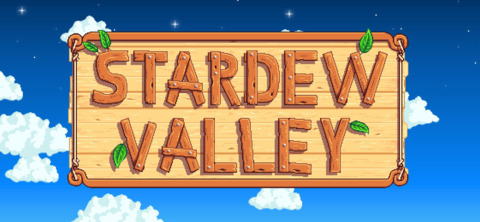
Like many of you, albeit several months further away from its release in February of this year, I've been spellbound by ConcernedApe's Stardew Valley: a retro/pixel farming and life simulator set in an idyllic burg with an abundance of NPCs to befriend and revenue-generating professions to pursue. Frankly, I wasn't really convinced of its endless appeal even after "Dirty" Dan Ryckert extolled its virtues on the Bombcast a few months back, as he remained the single voice of passion for the game in a manner comparable to how he was the only person on GBWest's staff to give two hoots and a Napstablook about the similarly friendship-heavy and visually low-key Undertale. I find that Dan's views mirror my own more closely than anyone on the Bomb Squad, though, and duly added Stardew Valley to my Steam wishlist in preparation for the next big sale. One of those sales happened recently, and so I've found myself spending as much time as I can free up to till the land, plant some crops and spend the rest of my daytime chasing after any number of short- and long-term goals.
But it has given me pause for thought. I've played games similar to Stardew Valley before, and in each successive case I've reached that point of total saturation earlier and earlier. Yet I feel I could play Stardew Valley for another week straight and still not tire of it, nor fully exhaust everything it has to offer. What I'd like to do here is to try and put together an explanation for why that is; expanding on the many layers of Stardew Valley's onion-like structure and why this game in particular is sticking with me in spite of my dropping out of easygoing contemporaries like Animal Crossing and Harvest Moon comparatively quickly. I suspect it has a lot of overlap with why I adore Dark Cloud 2/Dark Chronicle so much, but we'll leave the conclusions for later. Possibly at the end of the article, depending on how conventional I feel like being.
Since I haven't been tested for insanity recently, I'm going to ask myself a series of semi-rhetorical questions and see if I can respond by analyzing whether or not they're the root (so to speak) of Stardew Valley's pastoral charms. I mean, let's not kid ourselves here, it's a workable framing device.Welcome to Framing Simulator 2016.
Is it the farming?
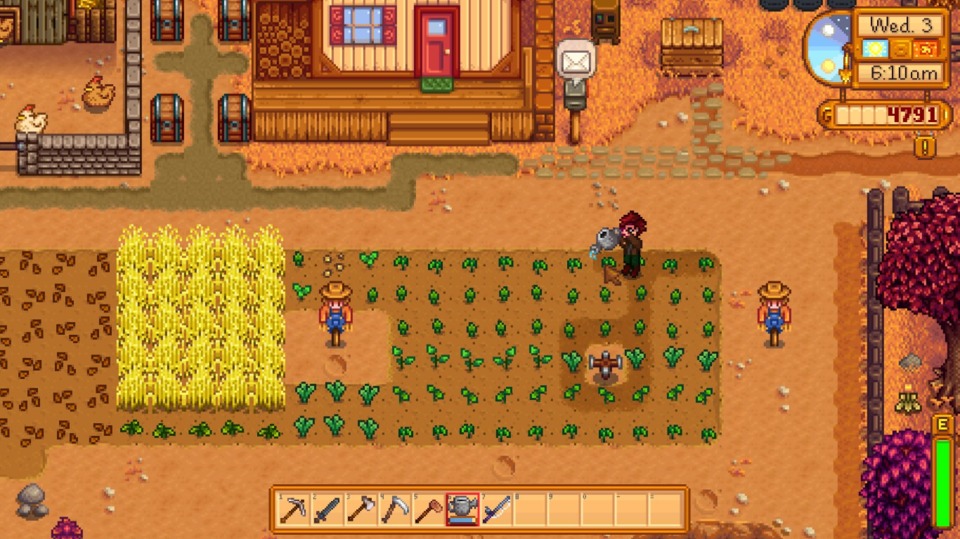
You'd be forgiven for thinking the farming was the chief focus of Stardew Valley, since you first arrive there to run your deceased grandfather's farm and whatnot. Everyone refers to you as "farmer" (or whatever your character's name is if they're feeling charitable) and most of the game's progression is linked to what you are able to farm on the immense plot of land you have to work with during any given season. However, there's a surprising amount of versatility given to how much time you're willing to spend tilling, the hours you'll drop on crops, your finite lifespan spent with a watering can, etc..
To farm, it's simply a matter of preparing the land, sowing the seeds and watering the budding crops every day until they ripen, at which point they can be harvested and sold. It's an exercise in delayed gratification, as a few dozen fully grown veggies and fruit can give you a major financial boost towards anything else you might be working towards, whether that's structures to house additional livestock, home improvements or helping to fund any number of alternate activities you might be getting involved with. You have the choice, therefore, of maintaining a moderately-sized farm that won't require too much time and energy to water every day and diverting those resources towards more subjectively engrossing activities like fishing or spelunking the local mines, or building a farm so big that you're spending almost every day maintaining it - only using the occasional rainy day to pursue other interests - for the sake of your profit margin.
What's great is that crops have all manner of other uses beyond cold hard ducats, and you're very much encouraged to be growing something at all time. There's a bit of a planning edge to it too, as a season is exactly 28 days long and crops will wilt and die if they aren't in season, so buying seeds that will mature after twelve days with only ten days left on the calendar is not exactly the most conducive path to riches. In addition, you also have crops that continue to produce vegetables/fruit as long as the plant is alive, and these are worth getting planted early if you're going to get the best returns. It's considerations like that that make the farming more engaging and strategic beyond the daily chore of watering everything. When that harvest finally comes in and you have a few extra thousand "stardew bucks" with which to make it rain on the local vendors, it's a joyous occasion.
Is it the foraging?
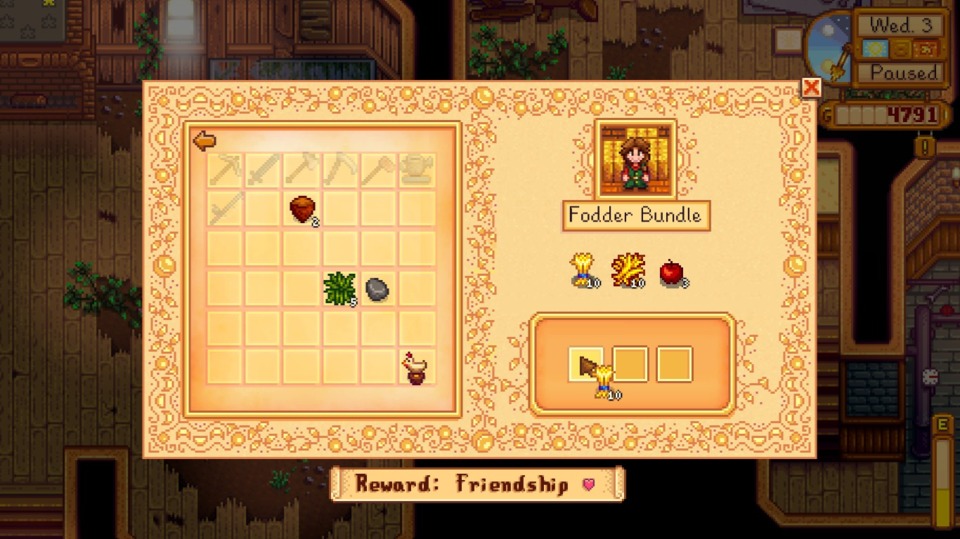
Early on, your best source of income is stuff you find on the ground or in trash cans. While nearby NPCs don't react well to your raccoon impression, there's all sorts of great items that people just throw away. Ground items tend to be seasonal plants, like wild grapes in the summer or leeks in the spring. It's not particularly compelling to run around the various wilderness areas of Stardew Valley and sweep up all that free money, but it's one of the first indications you get that you can start generating some fast revenue without waiting patiently for all your crops to show up. Skipping ahead to when your produce is ready to be plucked is absolutely not the way to play Stardew Valley, or at least not the most efficient or entertaining practice - though, as previously stated, there's a lot of freedom offered to the player in how they choose to spend their time in the valley.
What you also discover, shortly into the first season, is that there's a community center you can donate items towards to receive rewards and expand other areas of town. These item collections include the seasonal forage items, as well as seasonal crops and flowers, fish, artisanal bespoke goods like cloth and cooking ingredients, gemstones and bundles of cash. Stardew's not without its areas and secrets to reveal, and these little scavenger quests are the key to unlocking a lot of that. The game has an immense library of functional items that the player can find, grow, fish, cook or acquire through crafting buildings and contraptions, and so while the foraging begins as picking various plants growing everywhere in the Valley, with some DIY construction it can soon include eggs, maple syrup, honey, preservatives, wool, mayonnaise, milk, cheese and industrial gold bullion. You know, the usual commodities you find on a farm.
Is it the fishing?
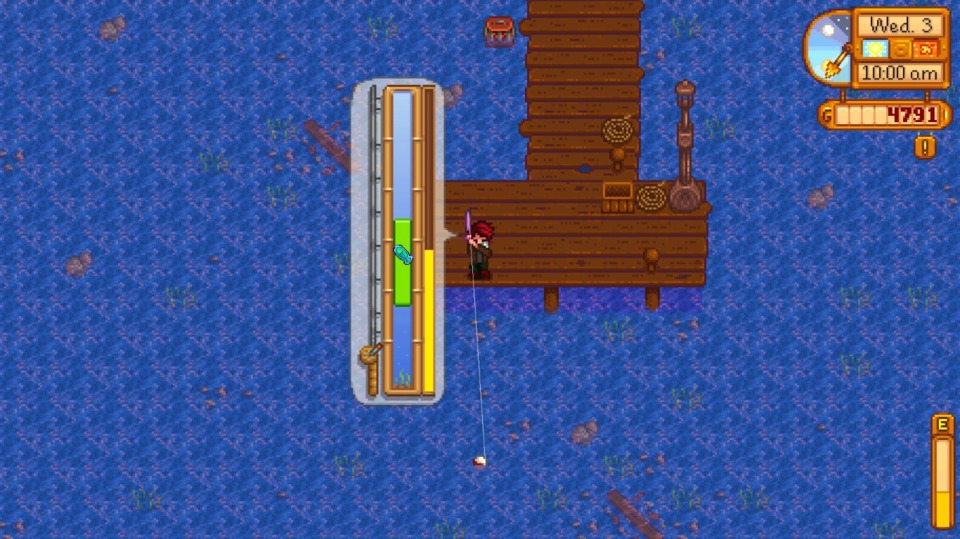
I actually really like the fishing, but the mini-game involved gets tricky fast, especially with the rare and difficult-to-catch fish. Fishing is highly conditional, often producing different catches depending on your fishing spot, the season, the weather, the time of day and the quality of the rod you're using. Fishing can be lucrative early on, with many fish commanding comparatively high prices given how easy they are to acquire. Once you get a decent rod and a steady source of bait, you'll find that most have the quality stars attached - these stars, either silver or gold, indicate a higher value and are usually the result of the player adding an extra bit of effort to their prep work. For fishing that can mean bait and rod quality, special fertilizers for farming, high-quality ingredients for cookery, the animals' happiness for animal goods, and sheer luck of the draw for almost anything else.
What I particularly like about the fishing is that they attach a small chance to catch a treasure chest of items from a random pool, which include valuable gemstones and semi-precious rocks along with other valuables and junk. The way these chests appear on the fishing gauge, which follows a common fishing mini-game theme of keeping a rapidly moving fish icon within a green zone that the player manipulates, means that the player has to risk losing both the fish and the treasure by opting for the latter over the former. Once the player has a very high quality rod, though, they can set their own lures and sinkers to boost the size of this green zone, the frequency of the fish biting, the speed of the fish icon and a treasure-friendly lure that stops the fish escaping whenever you chase a treasure icon. It's fairly sophisticated for what initially appears to be a throwaway RPG fishing mini-game, and yet like most of Stardew's features it's something you can choose to downplay or entirely ignore if it doesn't suit your palette and want to focus on other areas. Plenty of fish in the sea, as it were.
Is it the fighting?
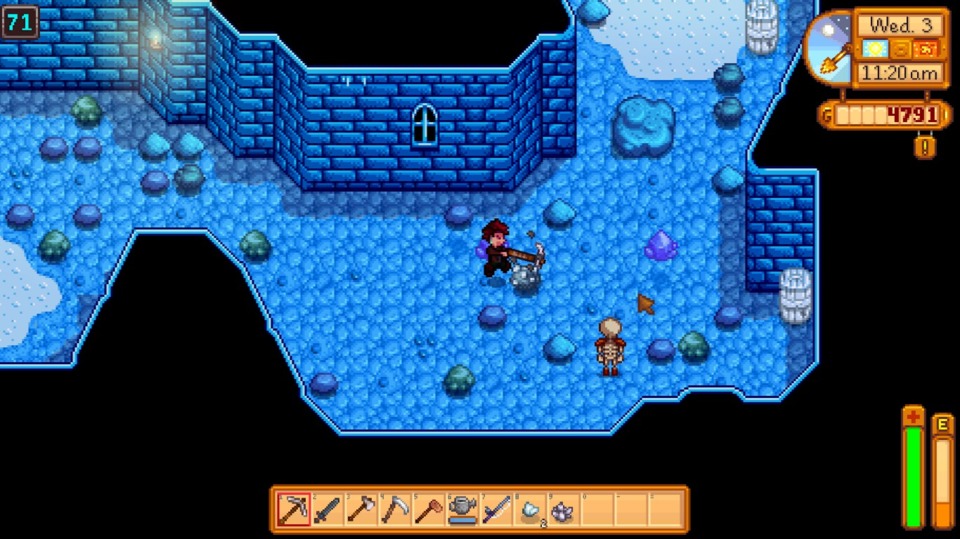
Taking a leaf from more recent Harvest Moon spin-offs like Rune Factory, which adds a fantasy setting and an RPG dungeon-crawling aspect to the usual farming and romancing, Stardew Valley has a mineshaft that has some familiar dungeoneering rules that smartly tie into the game's second universal party-pooper limited resource after its rapid clock - the energy bar. The player character's energy is refilled at the start of each day and can be restored through various means, though these means are few on the ground once you're several floors deep into Stardew's unusually abyssal mineshaft.
The goal of this particular part of the game is to get as deep as possible before your time or energy expire. The deeper you go, the better the rewards. The game lends a hand by providing an elevator that stops at every five floors, so you can return to any floor you visited previously as long as it's divisible by five. In order to drop one floor, however, you first have to find the exit by clearing out monsters and rocks that litter the ground, each of which has a small random chance (which is presumably determined when the floor is randomly generated) of producing a way down. Monsters sap your health, a separate bar from your energy that can lead to very bad things if it happens to run out, while breaking apart rocks saps your energy. The mines are the best place to find minerals though, many of which are required for construction, and can often yield artifacts and gemstones which can be sold or donated to the museum in an Animal Crossing-style collectible side-quest. Many of these gemstones are locked away in geodes, which require a visit to the blacksmith and a nominal fee to open and can produce anything from diamonds to worthless rocks.
I spoke about comparing this game to Dark Cloud 2 earlier, and it's more overt when the game chooses to take on the mantle of a dungeon-crawler RPG like this. It works not because the dungeoneering is particularly enthralling, but because it's never the only option available to you. By pacing yourself with dungeon visits, going days focusing on other tasks like fishing or clearing some arable land back at the homestead, it maintains its monster-bashing and mineral-collecting appeal throughout the game's runtime. Players can also buy new armor and weapons, though these are fairly perfunctory and offer incremental stat bonuses needed to stay alive. The player can, however, opt to take different specializations as they increase in level, choosing to boost their critical rate in lieu of a straight increase in damage output. This level-based progression exists for all the above "jobs" too, incidentally, and offer various ways to specialize your preferred approach (are you more into skill-based angling, or luck-based crab pots? Prefer waiting for those big payouts when growing crops, or the modest daily income from harvesting animal products like eggs and milk?).
Is it the fsteaks?
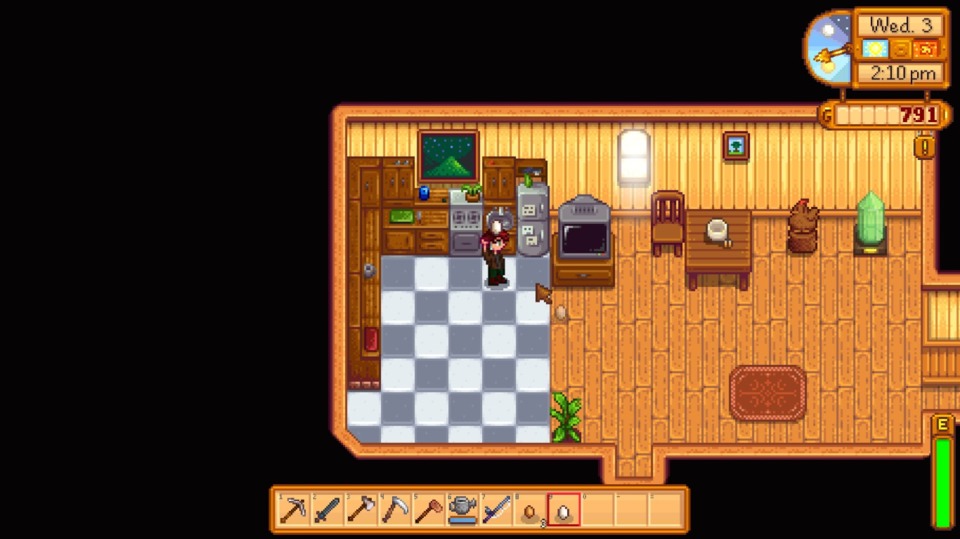
After upgrading your home the first time, you finally get access to a kitchen. This means storing all your leftover food products in the fridge and preparing meals that can either be sold, eaten for energy or given away as gifts. Villagers particularly seem to appreciate a well-cooked meal as a present, though the trick is figuring out which ones like which types of food. New recipes trickle in from watching TV or buying them from vendors, but the ingredient requirements for many of the meals require that the player be fairly well-established in their farming and other tasks: some basic ingredients like sugar, rice, oil and flour can be bought from the local grocer, but the player will have to source the rest themselves. The benefits of carrying a few omelets and salads around outweigh the inconvenience of getting all the necessary ingredients together, however, and it's worth setting a few of your produce aside for some home cookin'.
What I appreciate here is that the game doesn't skimp on recipes. There's at least a hundred different meals you can put together with the ingredients you can acquire, and many of them will temporarily boost your talents at fishing or dungeoneering as well as providing considerable energy and health refills. It shouldn't be understated just how powerful the right gift at the right time can be also, and though I've yet to get particularly far with any NPC friendships, I've already unlocked a few fun hanging out cutscenes.
Is it the friendships?
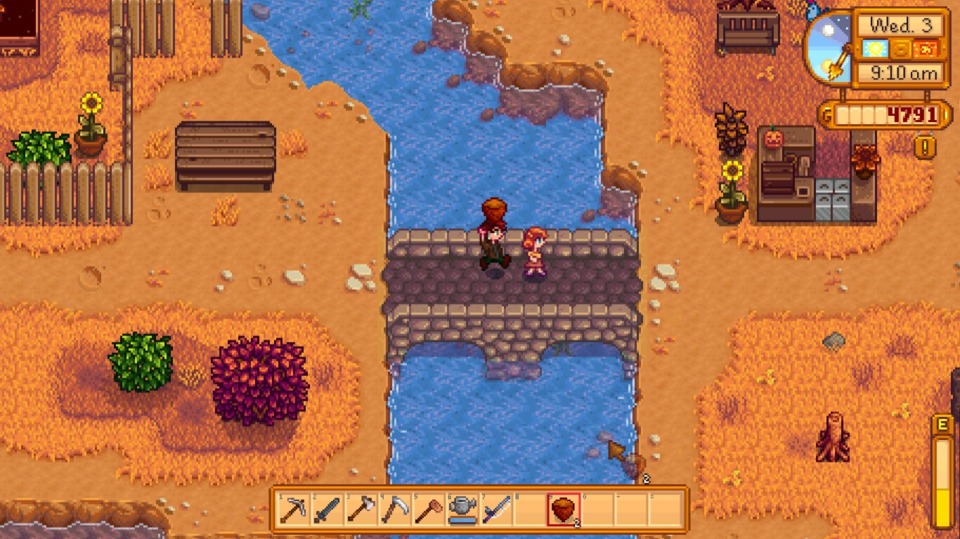
Which leads us to the NPC relationships. The game does do the romance thing, giving you the chance to woo five eligible partners of either gender, but almost everyone in town has a friendship meter that you can boost with gifts and correct responses in conversations, and I'm curious to see what would come of, say, befriending the local bartender or the eccentric wizard at the edge of town. The romantic partners have an obvious end-goal, but I'm less certain about what might result from a close friendship with the various married adults, children and old people in town. It takes some effort to boost those friendship gauges, not to mention giving away a lot of valuable shit, but I'm definitely curious enough about the outcome to give it some thought.
The game lets you hurry the ingratiation process up a little with NPC birthdays, which significantly boosts the positive effect a gift will have on those days. That means keeping a close eye on the calendar, however, and observing when everyone's birthdays occur. Unfortunately, your player character doesn't appear to have their own birthday, so no getting a windfall of swag one day out of the year.
As for the villagers themselves, I'm actually growing fairly attached to them. They offer a few basic statements and advice whenever you happen to bump into them, but the game makes them feel like living people in the sense that they have conditional schedules that change depending on the whether or the day of the week. That can make them difficult to track down at times, and the game unfortunately lacks an observable NPC schedule like the one in Majora's Mask, but it's nice to know they all have their own lives to lead and won't just hang around the same spot every day waiting for you to notice them.
Is it the Final Fantasy?
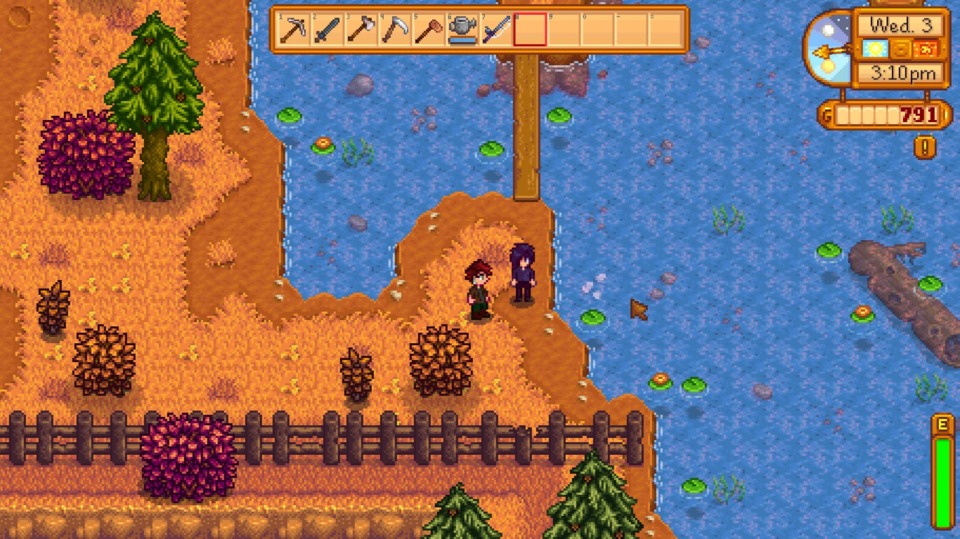
It's a stretch, but part of the appeal could lie in the retro 16-bit graphical style, which owes as much to classic 16-bit RPGs and early games in the Harvest Moon series as it does to the visually similar and far more recent sandbox game Terraria. In fact, I think Terraria was the last game to offer this level of player agency that I found myself this attached to, and that causes me to wonder how much of Stardew Valley's immediate success was due to that strong visual connection. Of course, pixel-based art and RPG Maker-looking games are a dime a dozen on Steam, sometimes literally if there's a sale on, so perhaps the secret of the game's appeal lies elsewhere.
Is it the finding of secrets?
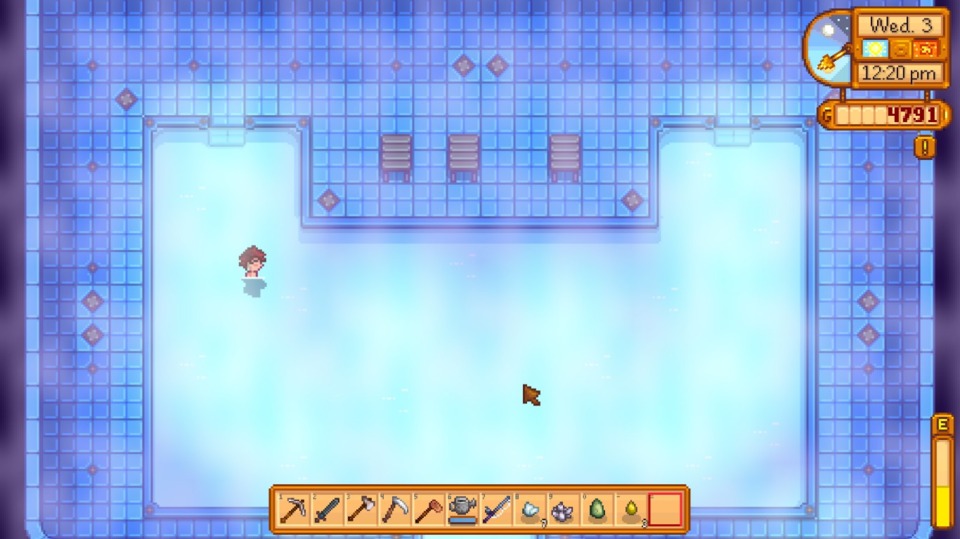
Stardew Valley is built in such an intelligently ambiguous way that the player has to discover almost everything on their own. That includes the above fishing calendar, the likes and dislikes of the NPCs, the value of certain items and the returns you can get from large investments like a barn or a chicken coop. It can also involve the town itself, and its surrounding environs. The game, especially early on, regularly unlocks new parts of town but doesn't really give you a particularly overt rundown of what is newly on offer. Completing the scavenger hunts in the community center are attached to concrete rewards like "fixing the minecarts" or "repairing the bridge" without actually telling you why you would want those additions.
Likewise, the north part of town where the railroad is, which surreptitiously unlocks after an earthquake a month into the game, seems to offer no obvious benefit whatsoever. It's only when you realize that passing trains, if you can reach them in time, offer free item drops as they pass by, and that the local spa in the same area can restore all your energy for the time cost of a lengthy soak, does it become clear how valuable it is to occasionally take a walk and see what's suddenly available. The game can unlock these areas after enough time has passed, but most of the time it's down to the player to instigate and investigate any new changes made to the local geography, because they're nearly always positive and can have a strong influence on how you play the game from that point onward.
There's also something to be said for the way the game creates long-term mysteries to keep you engaged in the day-to-day grind. These range from annual special events with the villagers that can occasionally require the player's input to make them perfect, like the potluck luau seen in Giant Bomb's Quick Look, to the various supernatural underpinnings in the game like: What's at the bottom of the mine? Why does your grandpa's shrine have an ominous note about returning to that point on the dawn of the third year? What happens when you fulfill all the community center objectives for the little nature spirits that live within? What happens if you choose instead to throw in with the vaguely sinister and invasive JojaMart at the edge of town? Where do all those weird noises come from whenever it's raining? What's in all those areas of town you can't reach yet? These questions naturally spring up as you keep playing, and it's a large part of the reason I can't seem to put the game down. If you need some of kind of "end-game point" to work towards to keep you invested in a potentially endless open-world game like this, and I know I do, it seems Stardew Valley has a few to choose from. I suppose when the day arrives when there are no more mysteries to solve is the day I stop playing - though it seems the developer intends to keep adding new material regardless, so maybe that day will never come.
Is it the finale of this friggin' foolishly florid feature?
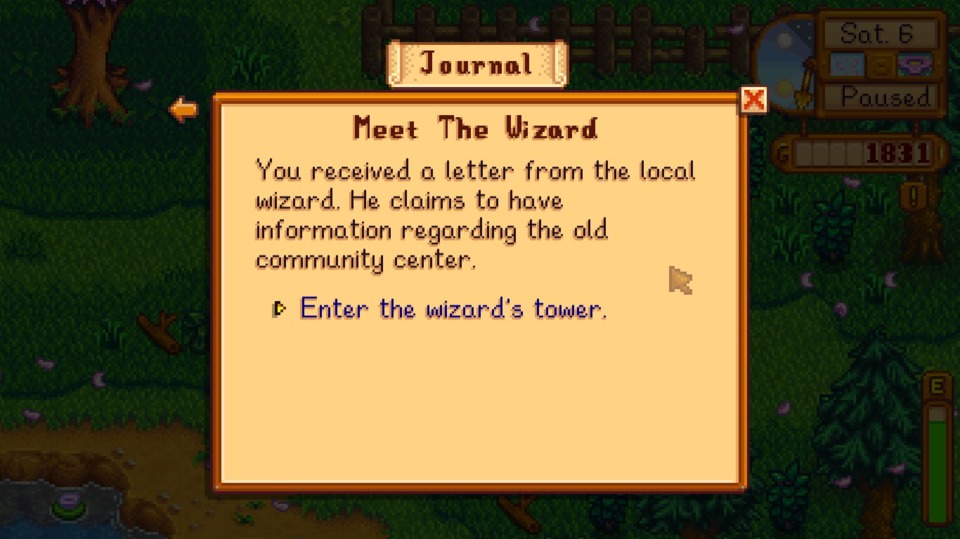
I've probably touched upon it several times by now, rendering this revelatory denouement largely moot, but the real appeal of Stardew Valley is that there's so much to do and to find and to figure out to an immense degree that's just on the safe side of overwhelming. Dark Cloud 2 rocked my world because you were never beholden to one style of gameplay the entire time: a key component of any game that presents itself as an "open-world" or "sandbox" game. Usually, though, these open-world games are fairly rigid when it comes to progression. Even with the theoretically endless creativity that something like Minecraft offers - whether you're building a fortress to creating a subterranean city to painstakingly crafting a life-size facsimile of the USS Enterprise NCC-1701 D to selling the license to Microsoft and becoming a weird, antagonistic recluse who lashes out at feminists on Twitter, you still have to start by digging and mining for the materials you need to build that first shelter, finding a way to protect yourself from creepers, fashioning stronger equipment from the ores you find, and so on.
While Dark Cloud 2 did have a core story-based progression that the player would need to return to occasionally, it also presented many different methods to pass the time that would all tie back into that core progression in a beneficial fashion, from using the fish you caught as cheaply-sourced restorative items to using ideas from idle photography to craft new equipment to building up your "georama" villages for additional resources and vendors. Even if you were willfully ignoring the next floor of the game's dungeon crawl for as long as possible, you were still working towards improving your character and the world around them in one manner or another. If anything, Stardew Valley gives you even more freedom and venues to explore in order to make your stay in the valley productive, lucrative and liberally gratifying. You can focus on any number of objectives and see how much progress you can make in any one discipline, or bounce between them capriciously, or just temporarily drop everything and go see what new discoveries you can find.
Now if you'll excuse me, I just bought a duckling and I'm not sure how the chickens are going to take to their new coopmate. I better go keep an eye on the situation in case there's any fowl play.
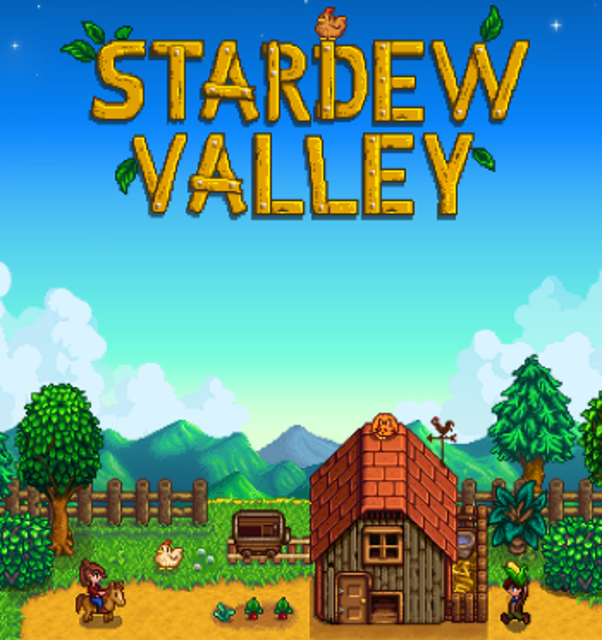
Log in to comment